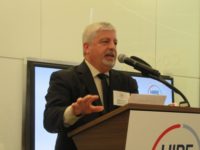Attempting to bring electric water heaters into the current era, civil engineer-turned-inventor Jerry Callahan says he has created a novel water heater that eliminates traditional modes of failure while increasing energy efficiency—and it has Wi-Fi.
Instead of using traditional heating elements, Callahan’s tankless heater, called the Model 1 by Heatworks, uses an ohmic heating process in which electric current is passed through water between 19 graphite electrodes.
Until the invention of this device, the ohmic method could not be used to attain the precise water-temperature control needed for domestic or commercial hot-water systems. Callahan claims the Model 1’s microprocessor achieves control by measuring and adjusting the output of electrical current 60 times per second.
As the electrodes themselves do not heat up, Callahan says scaling of minerals on internal components does not occur. “It’s actually pretty cool, because the only thing that gets hot inside the water heater is the water itself,” Callahan said, describing the system at a TechCruch presentation in May 2014.
The Model 1 has been in development since 2007, and Callahan hopes to ship by the end of July. The preorder cost is $395.
Ohmic heating now is used in food pasteurization, in which large amounts of material need to be heated uniformly. In a 2011 release, the Food and Drug Administration cited future uses for ohmic heating, including evaporation, dehydration and extraction.
The Model 1’s microprocessor also can be used to control functions such as peak temperature and temperature duration via Wi-Fi. Usage data also is made available for energy-consumption tracking, according to Callahan.
Mobile software accompanying the Model 1 lets users remotely change temperature profiles for water heating. Callahan calls one temperature profile the “baby preset,” which caps water temperature to make scalding impossible. “[It's] great for when the babysitter is over,” Callahan said at the TechCruch expo.
Besides heat-control precision and elimination of scaling, Heatworks also touts the product’s energy efficiency.
Tankless systems already offer energy savings, as heat is not lost while hot water awaits consumption. However, the Model 1 claims more than 99% efficiency compared to products of another electric-tankless manufacturer, Rheem, which claims a 94% efficiency rating on its website.
Heatworks acknowledges in supplementary material that a single Model 1 unit may not be enough to supply hot water to an entire home.
With a 40°F increase in water temperature, a single Model 1 unit would be able to produce up to 2.5 gallon per minute (GPM). After that, a second Model 1 would raise output up to 4 GPM, which corresponds to the federally mandated limit of 2.5 GPM for a shower head at 80 psi, according to the U.S. Dept. of Energy. These Model 1 GPM measures are of pure hot water, not the mixture of hot and cold water often coming out of the tap or showerhead.
The needed change in water temperature varies by location, as it depends on the temperature of the groundwater received. While a 40°F change produces 2 GPM, a 79°F change would produce 1 GPM.
The groundwater in New York City, which is around 50°F, is considerably colder than that of Florida, where groundwater can be up to 77°F, according to the DOE.
Callahan says the Model 1 addresses a problem consumers face when shopping for water heaters: a complicated market. The heater automatically detects and receives a connected voltage between 100 volts and 277 volts, and its maximum current draw can be manually adjusted from 15 amps to 48 amps in 5-amp increments.
The heater also can accept preheated water and boost its temperature up to the desired heat, according to Callahan, who lauds the Model 1’s versatility as a main water heater, point-of-use heater or point-of-use temperature booster.
The Model 1 originally was funded via a Kickstarter campaign, during which 1,398 backers donated $436,536—almost four times the developer’s $125,000 goal.
Callahan, a civil engineer, was previously COO of Great Lakes Dredge and Dock Co. He has served as president and CEO for a propane company, Blue Rhino. He started development on the technology behind the Model 1 in 2006, after being unable to find a water heater that met his needs while building an outdoor shower.
However, the startup CEO sees more than outdoor showers in the future. “It’s really an opportunity to refine how the world uses water in all applications,” Callahan said.



Post a comment to this article
Report Abusive Comment